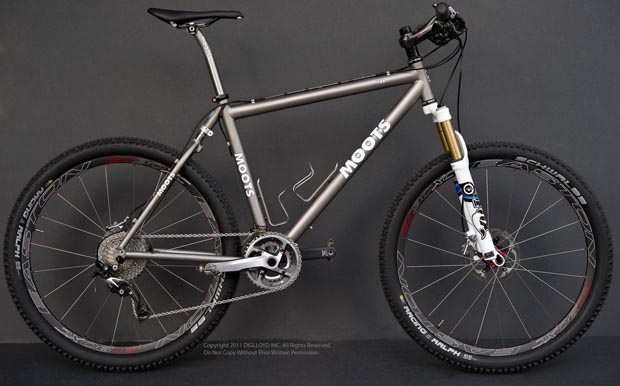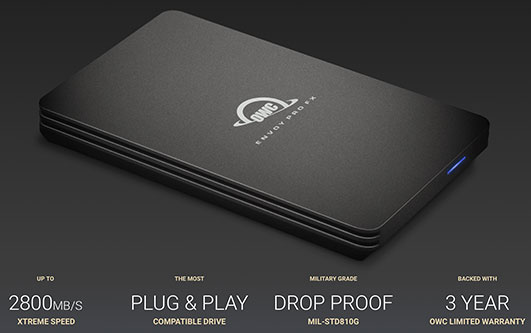2011 Moots YBB — Riding Notes
Related: Moots, Moots mountain bikes, mountain biking, noise, printing

Having test-ridden the Moots YBB 26, I was prepared for an outstanding ride, but instead I was impressed beyond my expectations— the Moots YBB 26 exhibits a magical combination of precise and nimble handling, comfort, and quick responsiveness.
I attribute the outstanding Moots YBB feel to these factors:
- Moots titanium frame geometry and YBB mechanism;
- 15QR front axle;
- Easton EC90 XC wheelset (very light and very strong).
I cannot separate which factor is most important, but it’s clear that there is a synergy at play with the sum greater than the parts.
Update! Comments after a month of use — August 21, 2011
The Moots YBB 26 eclipses any previous mountain bike I’ve owned or ridden. It is sheer joy to ride the YBB 26, and it brings a big grin to my face every time I ride it. My only regret is not owning one years ago. Even taking the cost into account, the grins-to-dollar ratio is exceptionally high, easily higher than any mountain bike I’ve ever owned.
After using the Moots YBB 26 hard for some weeks now (and having owned pro-grade Trek and Specialized dual suspension bikes previously), I offer the following comments, which of course are based on the way I built up my Moots YBB 26 with a 15QR axle and Easton wheels—
- At 22.4 pounds, the Moots YBB 26 is very light, but with no compromises to durability (as I’ve built it). The weight matters— not just for climbing, but in the feel of the bike going up or down or level or sideways.
- The Moots YBB 26 climbs extremely well, very efficiently. The YBB mechanism has very little effect on power transfer (I’m a very powerful rider, but I do have a smooth pedal stroke from road biking).
- The YBB mechanism is superior to conventional rear suspension in every way for my style of riding with finesse and threading a line: better handling, absolutely minimal power loss when sprinting (tire pressure is more of an issue!), no maintenance for years, no rear suspension lockout hassles, plenty of comfort for landing after “air”, predictable balance on jumps, etc. I have zero regrets on the YBB mechanism, and am thrilled with how much more I prefer it over a conventional rear shock.
- The Moots YBB leaps into the air off “water bars” while remaining perfectly balanced.
- Threads its way through the tightest trails, offering the most accurate “line” one might desire, no compensation needed for bike flaws— steering and body inputs are translated instantly and precisely into results.
- Stable yet lighting-fast handling for the tight twisty stuff.
- High speed descents with impunity: superior to any previous 26er I’ve ridden.
- Comfort: ample. The titanium frame, seat post and handlebar, along with the YBB mechanism and front shock are not cushy and flabby like a conventional rear suspension, yet offer more than ample comfort even on 3 hour rides. Overweight riders might think they need soft and plush full dual suspension, but the right solution there is to lose the gut to save the butt, and develop finesse rather than try to bang over every obstacle.
The Moots YBB 26 is an incredible ride. The reviews I’ve read elsewhere do not do it justice.
More (including initial comments)
Gets better each ride
The YBB 26 felt great the first ride, but with each succeeding ride I was more and more impressed as I pushed the bike harder and harder. By the 4th ride, I was “dialed” and happy as a pig in sh*t. Never had I experienced such superb handling and comfort in a bike.
Just prior to taking delivery of the Moots YBB 26, I rode the Trek Top Fuel 9.9 SSL extensively on the same local trails. The Top Fuel is a terrific bike, but it unequivocally lacked the magic feel of the Moots YBB 26. The Top Fuel also remained a challenge to push hard— balance was not nearly so good, and the steering was nowhere near as precise, something I attribute to its 9mm front axle, whereas my Moots build has a 15QR front axle. Obviously, a Top Fuel could be retrofitted to 15QR at some cost, and this I’d suggest would be well worth it for owners, because everything else is great on the Top Fuel.
Dual suspension on Trek Top Fuel vs Moots YBB
Long ago I mastered the finesse required for riding a hardtail over really rough stuff. The Moots YBB offers an ideal compromise without the weight and complexity of full dual suspension. The YBB mechanism offers a huge advantage over a hard tail in compliance which adds a good measure of control to the ride. It is not a full dual suspension, but it’s enough.
For the really rough stuff, dual suspension is an advantage in soaking up bumps, but what surprised me in riding the Moots YBB 26 is that the handling is not only more nimble, but the combination of titanium and the YBB and tubeless tires more than made up for the dual suspension, all the while providing a more responsive feel under acceleration. I found myself going faster over the same trails that the Top Fuel gave me pause on, even those with substantial bumps. I attribute this to the more precise steering of the Moots YBB 26, with its 15QR axle, but I also strongly suspect that the frame contributes significantly to the way the bike responds to the terrain. Both bikes had tubeless tires and the same shock, so the variables are reasonably similar.
Follow the line
I can only guess (not having two identical bikes with 15QR and with 9mm axle to compare), but I think part of the handling is the 15QR front axle, which makes steering much less subject to flex and torque when turning. The 2011 Trek Top Fuel 9.9 SSL with its 9mm front axle suffers from imprecise steering and handling which made me quite nervous in some situations; I was able to zoom through the same sections of trails without hesitation on the Moots, even though I had more experience on the Top Fuel.
Balance in the air
I’m incredibly impressed with the balance of the Moots YBB 26. I was thrilled by just how easy it was to ride it fast, and I felt that I had the bike dialed in after 3-4 rides.
Descending at high speed and hitting a water bar for some “air” is great fun, and here the Moots YBB 26 shows great balance: just fly off and the bike stays where it ought to, unlike the Trek Top Fuel 9.9 SSL, which made me think I’d “lose it” in a bad way; the Top Fuel requires effort to balance. Presumably it’s the rear shock that needs to be accounted for. The fact is that after just two rides I could jump the Moots with confidence, but never did manage to feel comfortable with the Top Fuel.
Cable noise
There is some cable-slap noise and chain-slap noise on the rough stuff. Various solutions exist to quiet this down, which I’ll be exploring.
Hitting the bumps
It’s clear to me after riding the ultra-rigid Trek Top Fuel 9.9 SSL that more than shocks are involved in soaking up the bumps. The Moots YBB frame doesn’t flex in any way one can put a finger on, but it has a springiness that can be felt in comparison to the stiff feel of carbon. The lively feel gives great feedback which I find quite enjoyable, rather than a deadened sensation of shocks soaking up bumps. It is my feeling that the ride quality contributes to a feedback loop that helps me ride the terrain more effectively.
Wheels
The Easton EC90 XC ballistic carbon wheelset has a major contribution to make; the light weight and great strength makes the bike “flippable”— rock just ahead? Flick the front wheel around it just like that, with no surprises from wheel flex. Amazing. Heavier wheels have too much momentum to do that trick. I love the light and quick feel as compared to the pound-over-it approach— finesse is more fun than brute bashing over stuff. If I want to bash over stuff, I’ll go with a 29er.
The ability to instantly make minor course corrections means great handling through obstacle-course terrains. On some really rough protruding-rock singletrack I found that I could ride the Moots YBB more easily and faster than the dual suspension Trek Top Fuel 9.9 SSL, simply because controlling the wheels precisely was so easy. I did not expect this result, but this emerged as a revelation rather quickly.
Sprinting
With the Moots YBB 26, when it’s time to sprint, you just go. The YBB mechanism has minimal effect on sprinting for anyone with a reasonable pedal stroke, and there is no rear shock to lock out and yet still remain sloppy. That simple fact means that one may completely ignore the rear suspension, which is not the case with a dual suspension bike.
Well worth noting is that lockout mechanisms for dual suspension bikes do not always lock out so well, and in fact the Trek Top Fuel 9.9 SSL mechanism went sloppy in this way after the Trek to the Summit of White Mountain Peak. A conventional rear shock means maintenance, and more to think about when riding. I’d rather focus on riding.
Conclusions
I’m thrilled with the Moots YBB 26 because it has exceeded my high expectations. Moots has really dialed in this frame. I can’t say is whether a lesser or different build would ride as well, but my particular Moots build is simply magical.
Note: I strongly recommend the 15QR, as I feel this lets the YBB frame perform at its handling best. Ditto for any brand.



